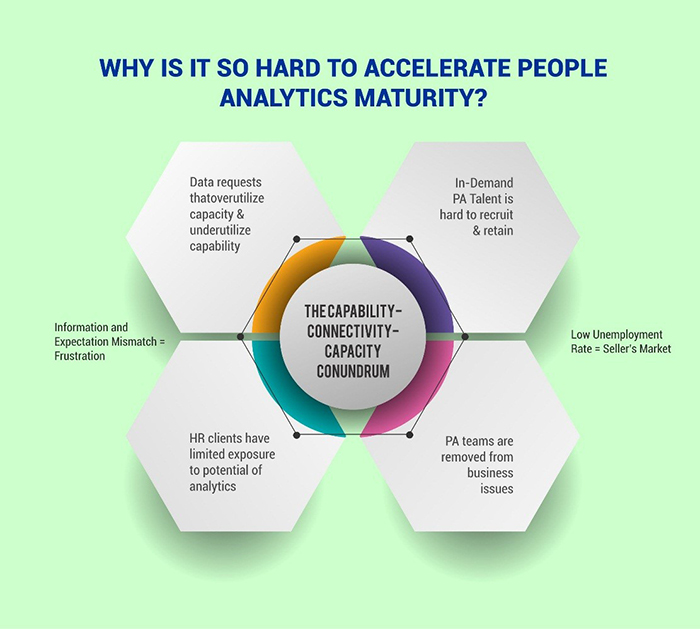
While professional intuition was once the only option, it was never the best answer for recruitment, retention, and engagement. With the increasing mentions of HR in the same sentence as of organizational strategy, people analytics cannot be sidelined or neglected. Companies are getting smarter, more tech savvy and they are gearing up for a change. Much of this change deals with people analytics with statistics, technology and expertise backed by large talent data sets.
Deloitte’s High Impact People Analytics study said that by the end of 2017 69% of large companies had a people analytics team. With employee engagement hogging all the limelight, the graph from here is upward bound. The intention is to drive employee experience all the way from the time prospective candidates are still vying for a job until they have left the company.
But are companies doing it right by People Analytics or is it just another trend lost in translation?
Like all things, People Analytics Maturity is easier said than done (or achieved). The capability-connectivity-capacity conundrum stands as a fortress against the road to maturity.

It is all about people and the culture – the two biggest catalysts and the biggest roadblocks towards People Analytics Maturity. With the cryptic code of culture and sub-cultures, decoding the permutation and combination to a data driven culture is the Goliath – companies need a David to slay it.
The first focus (or the David) should be on the first ‘C’ of the conundrum, aka capability. Seminars and training sessions create HR clients that are literate in People Analytics. With a basic data literacy across business units, People Analytics teams can look forward to upskilling, unlearning and re-learning. The next capability focus is directly for People Analytics teams and it involves strategies to create relevant technical know-how based on internal functions. Enabling them to gauge data accuracy and creating the workings of a multi-channel data listening platform are the major focus areas.
Data democratization takes us to the second ‘C’ – Capacity. Create data sets accessible in the cloud for the entire HR team to access. Multiple data listening channels will leave a large volume for the People Analytics team to analyze. Prioritizing what is actionable will be crucial as the capability grows. Focusing the capacity on the project with the most profound business impact to the least in descending order will make the People Analytics function more effective.
Once you are done with the first two Cs, the third and the biggest one remains – Connectivity. It starts with the People Analytics team working in the capacity of HR Business Partner 3.0, where the analyst provides data driven intuition and business acumen to the clients (marketing, finance, sales, operations and other departments). The People Analyst here needs to be on-board the client ship. The days of cubicle-bound, lone-wolf analyst are waning as the need for a multi-disciplinary People Analytics team becomes imperative.
People Analytics Maturity takes a shift to probability analysis, strategy feasibility and scenario planning as a liquid workforce compels it to go beyond the traditional KRAs. The much anticipated future of work is here and the tectonic shift in People Analytics will take it closer to the Corporate Strategy realm while the HR function lingers at its base.
A fluid workforce and a focus on employee experience is pointing towards democratization of data to gain trust momentum among employees. The result will be a data driven culture and the complete evolution of People Analytics 3.0. As Al Adamsen, Co-founder and CEO of Insight 222, points out it will be the creation of a product-based People Analytics solution.
The entire premise of People Analytics sounds ambitious and may be rightfully so. Global CEOs are counting on it to gain competitive advantage as the scope of People Analytics moves from employee listening and workforce planning to creating business transformation strategies. One apt example is the impact Organizational Network Analysis (ONA) had on GM’s innovation to drive better business practice. The 4D model of Discovery, Development, Diffusion and Disruption helped to identify the brokers, connectors and energizers in the team and the result came out in the form of disruptive products like Maven and Book by Cadillac.
Organizational Network Analysis, as the Chief Talent Officer of GM defined it, is a “new lens to evaluate how people show up in an organization.” And an Insight 222 study states that it is what most of the people analytics leaders will prefer to learn.
The renewed interest in this technical analytics methodology that has been there for the past 20 years is due to Passive ONA that acts as an “X-ray into the inner workings of an organization”. You can see the ‘Ultraviolets’ and ‘Infrareds’ (invisible to the naked eye) pathways of information flow in real-time in strategically crucial groups. Active ONA undertakes employee surveys to find out how employees feel about their workspace and is a good head start for the uninitiated. The Passive ONA in this respect is a continuous process and does not suffer from the issue of inadequate responses as its active counterpart does. The utopia for ONA is, however, to have a combination of both active and passive.
GM combined the Passive and Active ONA to understand the employees and bring the best possible combination to drive innovation. The next step was to create an ‘Adaptive Space’ that brings the most favorable environment to create and share ideas.

To put it out in simple words, GM just asked these questions:
All ONA did was answer these questions. It is not all sunshine all the time, however, as risk assessment and management need you to answer uncomfortable questions like:
The implementation of ONA in a European Retail Bank found that the non-performing branches had an interesting pattern of strong in-group culture that left out the new employees, rendering all the equal training and orientation redundant. A/B testing saw 50% of the branches with updated culture and procedure come up with 11% more loan sales compared to the branches that remained untouched.
People analytics has moved from research and analytics way back and forayed into data aggregation and visualization. But, the phase, albeit exciting, is passé as People Analytics 3.0 is all Productization and “Solutionize”. The only catch is it is high investment and high return proposition with the under taste of a high risk. Deploying People Analytics 3.0 will need companies to reach People Analytics Maturity and make use of technical analytics like ONA to reach what scientists call as the “Standard Temperature and Pressure” situation of Analytics Effectiveness.

CredBadge™ is a proprietary, secure, digital badging platform that provides for seamless authentication and verification of credentials across digital media worldwide.
CredBadge™ powered credentials ensure that professionals can showcase and verify their qualifications and credentials across all digital platforms, and at any time, across the planet.

Please enter the License Number/Unique Credential Code of the certificant. Results will be displayed if the person holds an active credential from TMI.